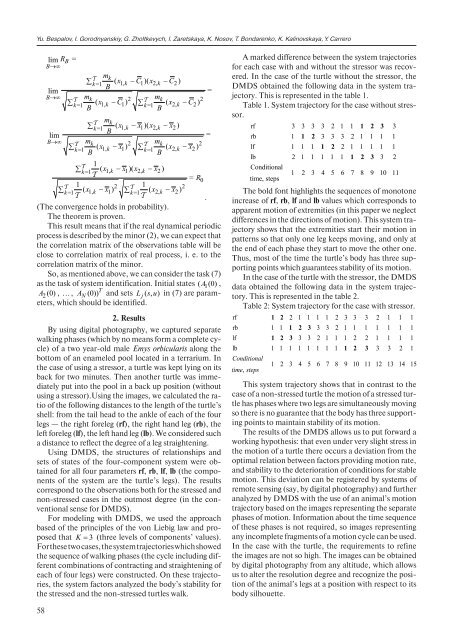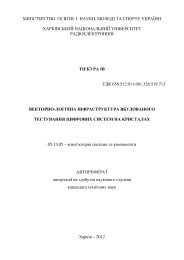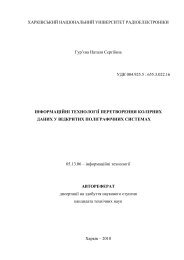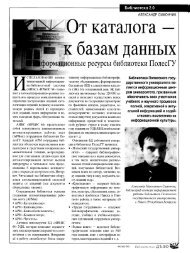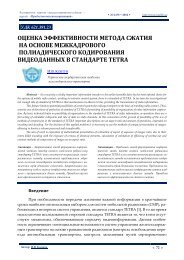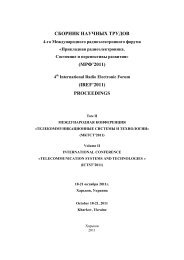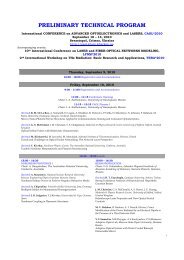информация, язык, интеллект № 3 (77) 2011
информация, язык, интеллект № 3 (77) 2011
информация, язык, интеллект № 3 (77) 2011
You also want an ePaper? Increase the reach of your titles
YUMPU automatically turns print PDFs into web optimized ePapers that Google loves.
Yu. Bespalov, I. Gorodnyanskiy, G. Zholtkevych, I. Zaretskaya, K. Nosov, T. Bondarenko, K. Kalinovskaya, Y. Carrero<br />
58<br />
lim RB<br />
B→∞<br />
=<br />
lim<br />
B→∞ T mk ∑k<br />
=1 ( x1, k −C1)( x2, k −C2)<br />
B<br />
T mk 2 mk<br />
2<br />
k=1 ( x1, k −C1) T<br />
∑ ∑k=1(<br />
x2, k −C2)<br />
B B<br />
=<br />
T mk ∑k<br />
=1 ( x1, k − x1)( x2, k − x2)<br />
B<br />
lim<br />
=<br />
B→∞ T mk 2 mk<br />
2<br />
k=1 ( x1, k − x1) T<br />
∑ ∑k=1(<br />
x2, k − x2)<br />
B B<br />
T 1<br />
∑k<br />
=1 ( x1, k − x1)( x2, k − x2)<br />
T<br />
= R0<br />
T 1 2 1<br />
2<br />
k=1 ( x1, k − x1) T<br />
∑ ∑k=1(<br />
x2, k − x2)<br />
T T .<br />
(The convergence holds in probability).<br />
The theorem is proven.<br />
This result means that if the real dynamical periodic<br />
process is described by the minor (2), we can expect that<br />
the correlation matrix of the observations table will be<br />
close to correlation matrix of real process, i. e. to the<br />
correlation matrix of the minor.<br />
So, as mentioned above, we can consider the task (7)<br />
as the task of system identification. Initial states ( A 1(0)<br />
,<br />
2 (0) A , … , A N (0))T and sets Lj( s, u ) in (7) are parameters,<br />
which should be identified.<br />
2. Results<br />
By using digital photography, we captured separate<br />
walking phases (which by no means form a complete cycle)<br />
of a two year-old male Emys orbicularis along the<br />
bottom of an enameled pool located in a terrarium. In<br />
the case of using a stressor, a turtle was kept lying on its<br />
back for two minutes. Then another turtle was immediately<br />
put into the pool in a back up position (without<br />
using a stressor).Using the images, we calculated the ratio<br />
of the following distances to the length of the turtle’s<br />
shell: from the tail head to the ankle of each of the four<br />
legs — the right foreleg (rf), the right hand leg (rb), the<br />
left foreleg (lf), the left hand leg (lb). We considered such<br />
a distance to reflect the degree of a leg straightening.<br />
Using DMDS, the structures of relationships and<br />
sets of states of the four-component system were obtained<br />
for all four parameters rf, rb, lf, lb (the components<br />
of the system are the turtle’s legs). The results<br />
correspond to the observations both for the stressed and<br />
non-stressed cases in the outmost degree (in the conventional<br />
sense for DMDS).<br />
for modeling with DMDS, we used the approach<br />
based of the principles of the von Liebig law and proposed<br />
that K = 3 (three levels of components’ values).<br />
for these two cases, the system trajectories which showed<br />
the sequence of walking phases (the cycle including different<br />
combinations of contracting and straightening of<br />
each of four legs) were constructed. On these trajectories,<br />
the system factors analyzed the body’s stability for<br />
the stressed and the non-stressed turtles walk.<br />
A marked difference between the system trajectories<br />
for each case with and without the stressor was recovered.<br />
In the case of the turtle without the stressor, the<br />
DMDS obtained the following data in the system trajectory.<br />
This is represented in the table 1.<br />
Table 1. System trajectory for the case without stressor.<br />
rf 3 3 3 3 2 1 1 1 2 3 3<br />
rb 1 1 2 3 3 3 2 1 1 1 1<br />
lf 1 1 1 1 2 2 1 1 1 1 1<br />
lb 2 1 1 1 1 1 1 2 3 3 2<br />
Conditional<br />
time, steps<br />
1 2 3 4 5 6 7 8 9 10 11<br />
The bold font highlights the sequences of monotone<br />
increase of rf, rb, lf and lb values which corresponds to<br />
apparent motion of extremities (in this paper we neglect<br />
differences in the directions of motion). This system trajectory<br />
shows that the extremities start their motion in<br />
patterns so that only one leg keeps moving, and only at<br />
the end of each phase they start to move the other one.<br />
Thus, most of the time the turtle’s body has three supporting<br />
points which guarantees stability of its motion.<br />
In the case of the turtle with the stressor, the DMDS<br />
data obtained the following data in the system trajectory.<br />
This is represented in the table 2.<br />
Table 2: System trajectory for the case with stressor.<br />
rf 1 2 2 1 1 1 1 2 3 3 3 2 1 1 1<br />
rb 1 1 1 2 3 3 3 2 1 1 1 1 1 1 1<br />
lf 1 2 3 3 3 2 1 1 1 2 2 1 1 1 1<br />
lb 1 1 1 1 1 1 1 1 1 2 3 3 3 2 1<br />
Conditional<br />
time, steps<br />
1 2 3 4 5 6 7 8 9 10 11 12 13 14 15<br />
This system trajectory shows that in contrast to the<br />
case of a non-stressed turtle the motion of a stressed turtle<br />
has phases where two legs are simultaneously moving<br />
so there is no guarantee that the body has three supporting<br />
points to maintain stability of its motion.<br />
The results of the DMDS allows us to put forward a<br />
working hypothesis: that even under very slight stress in<br />
the motion of a turtle there occurs a deviation from the<br />
optimal relation between factors providing motion rate,<br />
and stability to the deterioration of conditions for stable<br />
motion. This deviation can be registered by systems of<br />
remote sensing (say, by digital photography) and further<br />
analyzed by DMDS with the use of an animal’s motion<br />
trajectory based on the images representing the separate<br />
phases of motion. Information about the time sequence<br />
of these phases is not required, so images representing<br />
any incomplete fragments of a motion cycle can be used.<br />
In the case with the turtle, the requirements to refine<br />
the images are not so high. The images can be obtained<br />
by digital photography from any altitude, which allows<br />
us to alter the resolution degree and recognize the position<br />
of the animal’s legs at a position with respect to its<br />
body silhouette.


